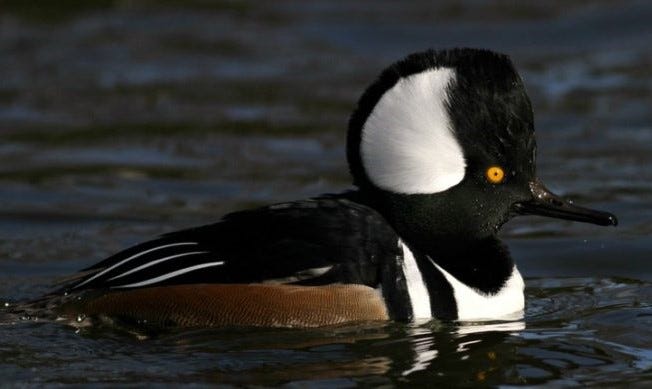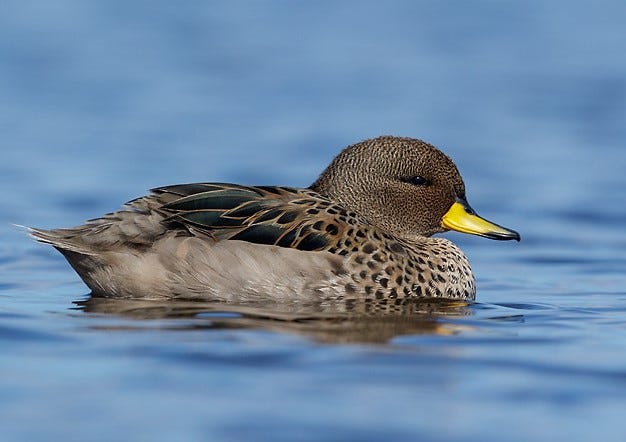
More than meets the eye
I was a self-professed “mammal person” when I embarked on my first ornithology course decades ago. I had nothing against birds, but they seemed more alien and less captivating to me than mammals. Nevertheless, tasked with learning about birds, I dutifully pulled off the road one afternoon on my way home from class when I spied a small pair of ducks floating across a woodland pond. I was familiar with Mallards, but this duo looked smaller and daintier than their ubiquitous counterparts.
I raised my binoculars and nearly gasped at the striking birds that filled my view. The flashy male was an elegant mixture of tuxedo-sharp black and white, with chestnut sides. His head was an ornate snow-white fan bordered in black, which he raised over a gleaming yellow eye and a dark, serrated bill. His mate was a more subtle mixture of grays and brown, with a russet crest and a black-and-yellow bill. Pulling out my field guide, I quickly discovered that they were Hooded Mergansers—small fish-eating (and crayfish-eating!) ducks that breed in forested wetlands throughout North America. After spending a few delightful minutes observing the lovely pair, I rushed home to phone bemused friends and family to tell them about the most exotic-looking creature I’d ever seen outside a zoo.
Those Hooded Mergansers opened my eyes to the diversity and beauty of the birdlife that lived around me—birds I’d never noticed before. I was fascinated to learn that these little diving ducks nest in tree cavities (or in nest boxes installed in forested habitats). If incubating female Hooded Mergansers evade a host of potential predators—from snakes to racoons to bears—their clutches of up to 13 eggs hatch after about 30 days. The fuzzy, chocolate-and-vanilla ducklings leap from the nest within 24 hours of hatching and immediately begin pursuing aquatic insects.
Although the striking mergansers sparked my interest in birds, it was another far-less-flashy duck that taught me, several years later, how much more there is to waterfowl than meets the eye. I spent four months in Argentina studying the breeding behavior of the Yellow-billed Teal (then aptly called the Speckled Teal), a diminutive brown duck that I could hold in one hand. We captured the teal by stringing nearly invisible “mist” nets in a grove of eucalyptus trees where the ducks nested inside large, multi-compartmented stick nests built by Monk Parakeets. We marked the ducks with unique combinations (different colors and shapes) of nasal disks that attached to either side of the birds’ bills, then observed the teals’ breeding activities and monitored their nests. I quickly learned that male ducks have some outlandish displays (with evocative names like “Grunt-whistle” and “Bridle”), but they also exhibit a variety of subtle ritualized movements that uninitiated observers might not realize are courtship displays. The ducks might raise or shake their head, or touch their bill to their wing as though they were going to preen.
In his most dramatic display, the Hooded Merganser shakes his crest to capture attention then throws his head backward until it’s lying on his back, and gives a froglike croak. But he will also raise himself out of the water and flap his wings or compress his crest and take a sip of water, letting the droplets fall from his bill. All of these subtle movements are designed to draw a female’s attention.
Each early spring I make a pilgrimage to my local wildlife refuge to look for and celebrate my spark bird—the bird that opened my eyes to the world of birds and forever transformed how I viewed the natural world. On my second trip to the refuge, I finally spied a pair of Hooded Mergansers, floating in and out of dry bulrushes on a quiet strip of water. The male compressed his crest, dipped his bill into the water, and let the droplets fall. This inconspicuous display to the mate who’d chosen him made me smile. And I realized that while flashy plumages invariably captivate, it is often the less obvious habits of birds that continue to fuel our fascination.
Because birds are so visible and vocal, they are often our gateways into the natural world, ambassadors on our journeys of discovery, and critical barometers for the health of our environment. Whether they provide that first spark that captivates us or the glowing ember that sustains our passion, birds have an endless capacity to surprise and delight, no matter how rough the waters may be as winter gives way to spring.

Take a small step to help birds
It’s easy to feel helpless in the face of habitat destruction and disappearing wildlife. But according to the US Fish and Wildlife Service, over 96 million people in North America watch birds. If each of us does something to help them, we may be able to reverse declining bird numbers.
Waterfowl have long been a conservation bright spot since they are one of the few groups of birds whose population numbers have risen since the 1970s. But a few weeks ago, conservation organizations released their yearly State of the Birds report and revealed that waterfowl are under pressure again. The loss of wetland and grassland habitats has accelerated, regulations that protect wetlands are being weakened, climate change is reducing available habitat, and incentives to farmers to conserve habitat are being undermined. You can support waterfowl (and grassland bird) habitat by buying a “Duck Stamp” (now called a Migratory Bird Hunting and Conservation Stamp). Waterfowl hunters are required to buy a Duck Stamp each year, but bird lovers can do so simply to support waterfowl and their habitats.
Tempting as it might be to feed bread to ducks in a local park, bread has no nutritional value for these birds and can even be harmful to them. Waterfowl are better off foraging for their own food.
Take a little time to watch birds and observe their behavior, rather than just identifying the birds that you see and moving on. The more we observe birds, the more we learn about them. And, often, the more we learn about them, the more we want to conserve them. Birds need our help more than ever in this moment.
Spring migration season is well underway! As a reminder, check BirdCast to see how many birds and which species are flying over your area while you’re sleeping. Seeing which birds are winging over us at night enriches our migration experience and deepens our appreciation for the incredible journeys our neighborhood birds make.
Until next time …
P.S. For more about my journeys of discovery among birds, check out a variety of podcast conversations about my new book Feather Trails, birds, and the threats they face.





Another wonderful piece! For those of us who truly watch birds, the myriad of behaviors, variety of colors, and diversity of species is absolutely stunning. I hope the world wakes up to how amazing birds are and how lucky we are to share our planet with the before it's too late!
Great article, Sophie! I’m not sure what my initial spark bird was, but my spark book about birds was David Attenborough‘s The Life of Birds, which dazzled me with so many amazing and fun facts about birds.